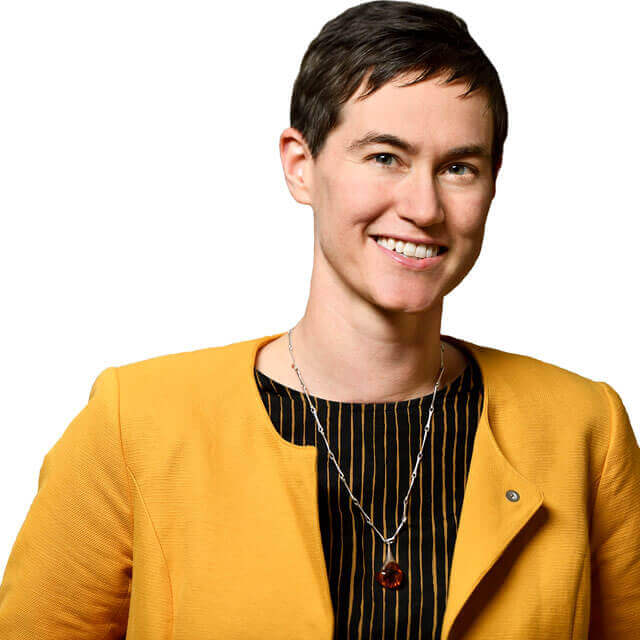-
About
- Health
-
Patient Care
I Want To...
-
Research
I Want To...
Find Research Faculty
Enter the last name, specialty or keyword for your search below.
-
School of Medicine
I Want to...
Features
Loud & Clear
Carrie Nieman and her team are opening a world of sound for senior citizens by bringing low-cost hearing aids to those who need them most.
Illustration by Pushart


Nieman hopes that Access HEARS will serve as a viable model that others can follow.
Tiffany Hertzman is busily setting up brochures at a Baltimore County senior center when a tall man with wispy gray hair, a quick step and a soft speaking voice approaches.
“Don’t go anywhere!” George Brown (not his real name) insists with quiet urgency. “I’ll be right back! I know someone who should see this.”
Hertzman isn’t going anywhere. In her role as a client services manager for the nonprofit Access HEARS (Hearing Equity through Accessible Research and Solutions), she visits senior centers, churches and other places around Baltimore where older people are likely to gather, providing information on low-cost alternatives to hearing aids.
Brown returns to Hertzman a few minutes later, this time with a friend in tow.
Kay Johnston (not her real name) has just finished up her morning water aerobics class. It would be easy to mistake her for younger than her 81 years. But like so many people in their 70s and 80s, her hearing isn’t what it once was.
“Sometimes the television is so loud that George is afraid it’s going to wake the neighbors,” she tells Hertzman. Johnston and Brown met at the senior center and spend much of their time together. They mostly get along fine, says Johnston, but when they do bicker, the source is often her inability to hear Brown’s quiet speaking voice.
The clashes are inevitable, and they’re always the same, she tells Hertzman. “He’ll say something to me, and I won’t hear him, and he thinks I’m ignoring him. Then he yells at me.”
“I don’t yell at you,” protests Brown. “I just want to make sure you hear what I’m saying.”
It’s clear that they’re fond of one another, but Johnston says the arguments have strained their relationship.
“I just don’t like it when you holler at me,” she says softly.
The Toughest Barrier
Access HEARS, “a pioneer social enterprise,” is the brainchild of Carrie Nieman, who launched the nonprofit as an otolaryngology resident at Johns Hopkins and is now an assistant professor of otolaryngology–head and neck surgery. The Access HEARS mission is to offer alternatives to costly hearing aids, particularly for older, underserved Baltimoreans.
“The ability to hear is crucial to aging well,” says Nieman. “Research is telling us that hearing loss may not be a benign part of the aging process. Age-related hearing loss has been independently associated with negative outcomes in almost every domain of aging, including cognitive problems, social isolation and even falls.”
According to the National Institutes of Health, two-thirds of adults 70 and older have clinically significant hearing loss. And only 10 percent of low-income adults with hearing loss use hearing aids.
Researchers have identified numerous reasons why people resist getting help for hearing loss. Often, people whose hearing has diminished gradually don’t acknowledge the problem. Others are daunted by the bad experiences that friends or family members have had with hearing aids.
But for many people, the toughest barrier to overcome is the price tag attached to hearing aids. Not covered by Medicare and rarely covered by private insurance, traditional hearing aids can easily cost as much as $3,500. And that’s just for one ear.
Hearing aids are not covered by Medicare and rarely by private insurance. One ear can easily cost as much as $3,500.
During her otolaryngology residency at Johns Hopkins (2011–17), Nieman set out to address such health disparities, and she found a strong mentor in Frank Lin ’03, associate professor of otolaryngology–head and neck surgery. Founder and director of the Johns Hopkins Cochlear Center for Hearing and Public Health, Lin has authored numerous studies linking late-life hearing loss to everything from depression to dementia.
Nieman devoted her residency research time to working with older adults across Baltimore, including at Weinberg Senior Living, a provider of subsidized housing for low- to moderate-income older adults. Her community work informed the development and testing of a two-hour hearing care program designed for older adults, dubbed HEARS, in which a trained peer community health worker covers the basics of age-related hearing loss and communication strategies, as well as a step-by-step fitting and orientation to an over-the-counter amplification device.
Nieman’s initial pilot study found that the program improved communication difficulties at least as well as studies that have relied on gold-standard hearing aids. (Based on her findings, the HEARS program was cited in a recent Lancet report as a promising innovation in increasing the use of hearing care and is currently being tested in a larger randomized controlled trial funded by the National Institutes of Health.)
“Because hearing aids are so expensive and not covered by Medicare, a lot of people who could really benefit from them don’t even consider looking for help with their hearing,” Nieman found.
In addition to prohibitive costs, says Nieman, hearing care also means visits to multiple medical professionals. Taking into account mobility and transportation challenges, plus the health literacy often required to navigate the system, Nieman says the disparities won’t go away on their own.
“Just getting to appointments is a barrier for a lot of people,” she says. “If transportation isn’t reliable or if physical mobility is an issue, that means many people who need help don’t get it.”
Nieman also questioned the typical pace of research, which can take as long as 25 years to bring an innovation into routine practice. To accelerate the research pipeline, Nieman brought her idea for Access HEARS—a nonprofit that would incorporate knowledge gained through her HEARS research program—to Kunal Parikh at The Johns Hopkins University’s Social Innovation Lab, an early-stage incubator that offers mentoring and funding to nonprofits and socially conscious companies.
Parikh, a biomedical engineer, was so impressed, he became a co-founder of Access HEARS with Nieman and Lin. Together, they worked to secure funding from the AARP Foundation, the Blaustein Philanthropic Group and the Johns Hopkins Neighborhood Fund.
By 2017, they had the money they needed to hire a few staff members and give the program an initial push. The nonprofit organization provides trusted, evidence-based, unbiased product information and alternatives to costly hearing aids to seniors with hearing loss.
Since beginning outreach two years ago, Access HEARS and the HEARS research study have brought low-cost hearing devices to more than 700 Baltimore-area seniors.
Says Parikh, “We’re rethinking a space that hasn’t been innovated in a long time.”
Simpler Solutions
Apart from the high cost of hearing aids, there’s a tangle of referrals, appointments and tests that can also act as barriers to getting help, says Nieman.
“That’s what we’re trying to change,” she explains. “Age-related hearing loss isn’t nearly as complicated as it’s made out to be. We’re trying to remove as many barriers as possible and present simpler solutions.”
The Over-the-Counter Hearing Aid Act, signed into law in summer 2017, promises to help. Passed largely due to the efforts and advocacy of Lin and colleagues, the law paves the way to loosen FDA regulations and allows over-the-counter sales of products for people with mild to moderate hearing loss. It also allows people to get hearing tests from audiologists without a physician referral.
The act opens up a new world of technology that is far less expensive than traditional hearing aids. The choices currently available in the burgeoning field of personal sound amplifiers are numerous—but they’re not regulated, and they’re not all created equal. Many make grand claims that fall short. And, while the devices are less expensive than hearing aids, they’re not cheap enough for low-income consumers to take a trial-and-error approach, buying new ones until they find one that works.
Fortunately, Access HEARS has been able to zero in on the effective products, thanks in large part to work led by audiologist Nick Reed, Nieman’s colleague at the Cochlear Center, including a 2017 study published in the Journal of the American Medical Association that found some of these low-cost over-the-counter devices work as well as hearing aids.
Based on those findings, the Access HEARS team landed on two options for personal sound amplifiers. Both can boost volume and filter out background noise or clarify sound coming from television, movies or radio.
The devices, which range from $80 to $400, are less customized and form-fitted than their costlier counterparts, but they are still vast improvements to living with untreated hearing loss, Nieman notes.
Equipping Neighbors to Help
Now that Access HEARS is up and running, Nieman leaves most of the day-to-day management to Executive Director Khoi Le. But Nieman’s vision continues to be a guiding force.
In Access HEARS’ early stages, sustainability has been a particular focus. Understanding the dangers of relying solely on grant-based funding, Parikh and Nieman have built a model where, they hope, monthly revenues of device sales can sustain and grow the nonprofit.
Nieman also hopes that Access HEARS will serve as a viable model that others can follow. “With the new law in place and the availability of over-the-counter technology, I hope we see more people doing the kind of thing we’re doing with the nonprofit,” she says.
Meanwhile, Nieman’s research in the field continues. She is currently working on a three-year randomized control trial of the HEARS program that could ultimately broaden access to personal amplification devices and up-and-coming, over-the-counter hearing aids.
As part of the study, Nieman’s team has trained 10 Baltimore senior citizens, all of whom live in senior housing communities, in peer counseling for age-related hearing loss. The peer counselors discuss hearing loss with their neighbors and teach them how to use personal sound amplifiers, with hopes of breaking down barriers to improved hearing. By the end of the study, Nieman aims to ascertain whether the peer counseling approach is effective.
“I’ve found that a lot of people I talk with don’t know how isolating and discouraging hearing loss can be,” says DeNiece Barger, 65, one of the peer counselors in Nieman’s study, who underwent eight weeks of training to be the volunteer representative in her building in downtown Baltimore. Over the past six months, Barger says, she has helped 12 of her neighbors select and learn how to use low-cost alternatives to hearing aids.
“I’ve found that a lot of people I talk with don’t know how isolating and discouraging hearing loss can be,”
—Peer counselor Deniece Barger
Among those 12 was a neighbor who had always seemed “grouchy,” Barger says. During their discussions, Barger learned that her neighbor had grown frustrated by having to constantly ask people to repeat themselves. And since the woman had trouble hearing traffic noise, she’d lost confidence crossing the street, which kept her mostly indoors.
But a little bit at a time, Barger made progress with her neighbor. “Because I live in the building, I think she saw me as someone she could trust,” says Barger.
The evening after she finally helped her neighbor select and properly adjust a new amplification device, Barger said the woman approached her excitedly.
“She was so happy,” says Barger. “She told me she’d gone outside and taken a long walk that day. It was just such a great feeling to see how happy she was.”
Fitted to Hear
Back at the senior center in Baltimore County, Hertzman explains to Johnston the vetting process Johns Hopkins researchers have gone through to decide on which personal sound amplifiers to offer.
Hertzman notes that the low-end version requires the use of headphones, while the more expensive model looks like a two-piece hearing aid. Because most of its clients face significant financial hardship, Access HEARS offers no-interest payment plans tailored directly to each client’s needs. Hertzman says they never want cost to be a barrier.
“We can work it out so you can pay every month until it’s paid off,” Hertzman tells Johnston, who selects the two-piece model. Made of durable plastic and silicone, the back is a silver half-moon with buttons for volume and for the type of sound the user wants amplified.
Demonstrating how one piece of the device loops discreetly behind the wearer’s ear, while the other rubberized piece fits inside the ear, like an earbud, Hertzman shows Johnston the volume and mode controls. She adjusts the fit, allowing Johnston to wear her personal sound amplifier behind her right ear, hidden by her hair.
“I don’t want people to see it,” Johnston says, tucking her hair over her ear. “I don’t want to look like an old lady.”
In only a few minutes, Johnston is acclimating to her new device. She and Hertzman set up an appointment to meet again at the senior center to answer questions and make whatever adjustments Johnston’s listening device needs.
Kay Johnston turns to her friend George Brown and smiles hopefully. “I think this is going to be good,” she says.
“I do too,” he replies.



